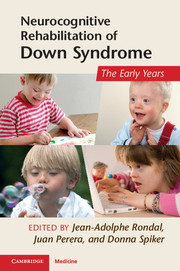Book contents
- Frontmatter
- Contents
- List of contributors
- Preface
- Acknowledgments
- Section 1 Definition, history, methodology, and assessment
- 1 Early rehabilitative intervention
- 2 The history of early intervention for infants and young children with Down syndrome and their families
- 3 Advances in clinical endpoints for neurocognitive rehabilitation in Down syndrome
- Section 2 Genetics, brain, and animal models
- Section 3 Pharmacological and medical management and treatment
- Section 4 Early development and intervention
- Section 5 Therapeutic perspectives
- Conclusions
- Index
- References
1 - Early rehabilitative intervention
Definition, objectives, models, and challenges
Published online by Cambridge University Press: 05 July 2011
- Frontmatter
- Contents
- List of contributors
- Preface
- Acknowledgments
- Section 1 Definition, history, methodology, and assessment
- 1 Early rehabilitative intervention
- 2 The history of early intervention for infants and young children with Down syndrome and their families
- 3 Advances in clinical endpoints for neurocognitive rehabilitation in Down syndrome
- Section 2 Genetics, brain, and animal models
- Section 3 Pharmacological and medical management and treatment
- Section 4 Early development and intervention
- Section 5 Therapeutic perspectives
- Conclusions
- Index
- References
Summary
Introduction
Realistic estimations indicate that some 780 million children may experience intellectual disabilities between birth and the age of five years (Olness, 2003). This figure represents the growing number of identifiable biological and environmental factors associated with intellectual disability, as well as those conditions that mean children are placed at risk.
Apart from the growing number of genetic and infectious causes of intellectual disabilities that are now recognized, conditions that can also lead to intellectual disability include: malnutrition, fetal alcoholism, cranial trauma, lead poisoning, low birth weight, and cancer, among many others. Environmental causes include the effects of poverty, the abuse of minors, and child neglect (Guralnick, 2000). These environmental causes often work in conjunction with biological conditions (Msall et al., 1998; Fujiura and Yamaki, 2000; Park et al., 2002). Furthermore, when we consider potential causes or risk factors, it is the cumulative effect that represents the greatest threat to the intellectual development of children (Sameroff et al., 1987; Burchinal et al., 2000). The number of children who are likely to experience intellectual disability in the world is overshadowed only by the diversity and complexity of the developmental patterns (Guralnick, 2005a).
However, expectations are relatively optimistic with regard to what can be achieved during the first six years of life if good early intervention (EI) programs are applied; that is, systematic, multidisciplinary programs based on experimentation (Guralnick, 1998).
- Type
- Chapter
- Information
- Neurocognitive Rehabilitation of Down SyndromeEarly Years, pp. 1 - 14Publisher: Cambridge University PressPrint publication year: 2011
References
- 2
- Cited by



